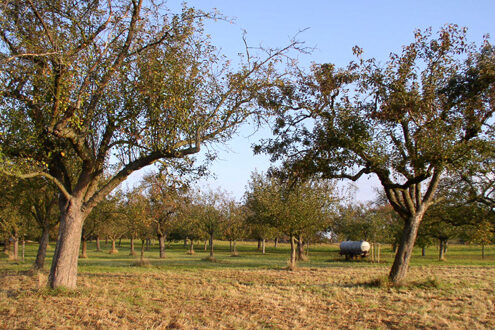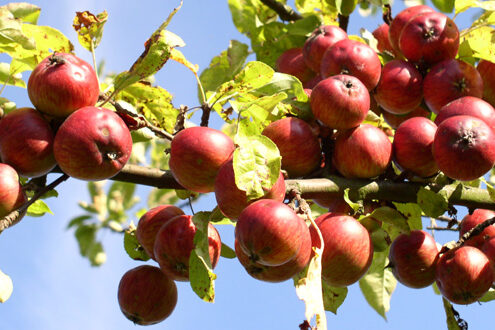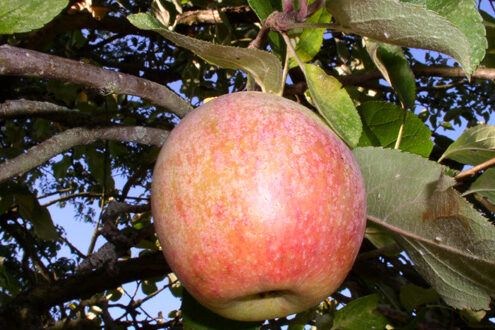Orcharding
Orchards, such as those found in various Wiesbaden suburbs, have many functions that are worth protecting. They are among the most species-rich habitats, protect against soil erosion and have a high recreational value.
Orchards are a landscape-defining element of the Wiesbaden districts. This includes scattered trees such as apples, pears, plums, cherries, walnuts and speierling. In contrast to orchard fruit, these are tall trees whose branches usually only start at a height of around 1.80 meters and which can live for over 100 years, depending on the type of fruit.
Orchards are endangered throughout Hesse, which is why this habitat is protected by law. Orchards have many functions worth protecting: They have a positive effect on the microclimate, have a high recreational value, prevent soil erosion and are one of the most species-rich habitats in our latitudes. Over 5,000 different animal and plant species have been recorded in the orchard habitat.
Orchards are now also recognized as nutritionally valuable. Scientific studies have shown that the juice of the old Celtic varieties in particular is in no way inferior to the antioxidants contained in red wine.
According to a 2007 evaluation, there are still 676 hectares of orchards in the city of Wiesbaden, which corresponds to 3.3% of the city area. The number of orchards has been declining for decades. This is mainly due to the fact that they are largely not used and the associated maintenance is largely neglected and trees that have died are often not replaced. At a time when apple juice is often produced using cheap apple concentrate from China, the price of domestic orchards has been at a very low level for years. The remuneration of 7 to 7.50 euros for a quintal of apples does not offer the farmers of orchards any incentive to continue tending their trees and meadows and harvesting the fruit.
The Streuobstkreis Wiesbaden e.V., a non-profit association, is dedicated to the preservation of orchard fruit in Wiesbaden. Almost 3,000 trees were examined during a variety mapping exercise commissioned by the association in 2008 in the important orchards of the eastern districts of Breckenheim, Rambach, Heßloch and Sonnenberg. Fruit trees between 1 and 60 years old accounted for only 38% of the total, while the old trees over 60 years old, the ruined trees and the fruit trees that had already died made up almost two thirds of the orchard. With the disappearance of these trees in the coming decade, the typical landscape will change.
Although the variety mapping only covered parts of Wiesbaden's orchards, a large number of fruit varieties, some of them rare, were recorded. For example, several specimens of a regional apple variety, the Kloppenheimer Streifling, were found. This was first described in 1854 and is named after the Wiesbaden suburb.
The main type of fruit in the eastern districts is the apple, with pressed fruit dominating over dessert fruit. The predominant use there was the production of cider, which is still traditionally practiced today, albeit to a lesser extent.
In the western part of Frauenstein, on the other hand, sweet cherries dominate. Frauenstein cherries are a household name and are often sold directly from street stalls. But cherries are also important in the eastern district of Kloppenheim, which is reflected in the increased proportion of cherry trees in the orchards. In Breckenheim, on the other hand, the pear is worth mentioning. The variety mapping has identified 22 pear varieties there, many of which are cider pears.
The Streuobstkreis Wiesbaden e.V. tries to contribute to the preservation of the orchard through numerous activities such as fruit tree pruning courses, product tastings by regional producers, guided tours, school projects, wine press festivals, variety exhibitions and care campaigns. Of particular importance is a variety garden inaugurated in 2004 in the Medenbach district, where at the end of 2021 there will be over 210 labeled trees on an area of around 1.3 hectares, which can be assigned to over 150 different fruit varieties. Here you will find other regional apple varieties that have Wiesbaden suburbs in their names: Auringer Bohnapfel, Schöner aus Schierstein, Rambacher, Nauroder Streifling and Igstadter Bohnapfel. A pear variety known in the region as the Auringer Winterbirne is also preserved there.
The association is also looking for the apple varieties Biebricher Weinapfel, Dotzheimer Zitronenapfel, Heßlocher Streifling, Nordenstädter Streifling and Roter Nordenstädter, which were thought to be lost.


